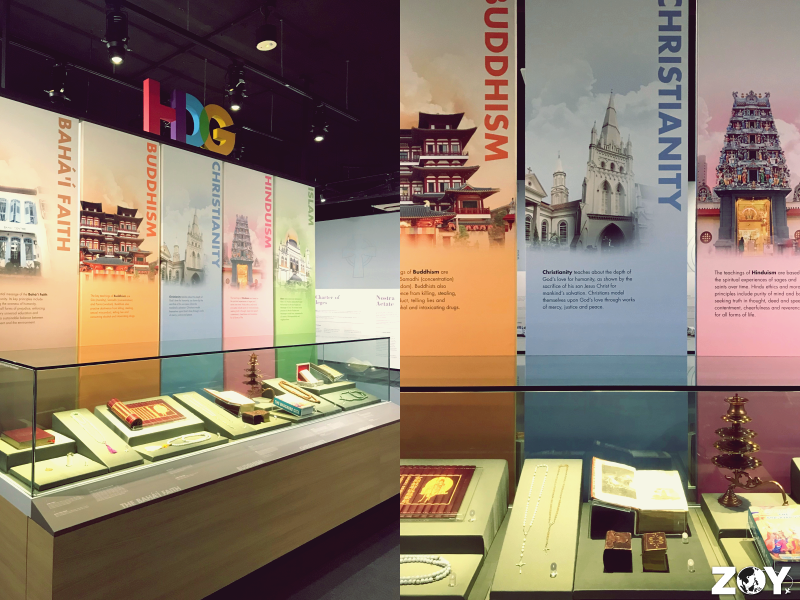SG Trip '19: Appreciating Singapore’s Religious Harmony at the Harmony in Diversity Gallery
Inside the Harmony in Diversity Gallery
I’m doing a month-long series on my Singapore trip back in September. It’s my 3rd time in the Lion City (I won’t get tired visiting it!) and I’ve been coming back for both personal development (gotta invest on myself!) and vacation (gotta get some break!). Hope you’ll enjoy this series!
Last Thursday, I wrote the first of two “appreciating Singapore” articles, which is about the Lion City’s efficient transport system and a dedicated gallery to it. Even though Singapore’s is hailed as one of the best in the world, they are continuously improving it and will not stop anytime soon. They have a vision for accessible and inclusive transportation for all people, autonomous vehicles, and smart infrastructures such as data-collecting lampposts, among many others. Truly, Singapore’s transport system is worthy of admiration and even envy!
But aside from its transport system, there’s another thing that I appreciate about Singapore—its religious harmony. This topic is interesting to me because first, I work full-time for a religious organization. Second and more importantly, Singapore is a multi-ethnic nation. This means that there is a diversity of religion as well.
So how do Singapore’s major religions get along? That is best explained with a visit to the Harmony in Diversity Gallery (HDG). Operated by and housed in the Ministry of Home Affairs, the HDG promotes the appreciation of Singapore’s religious harmony, which took years to achieve.
Here are 5 interesting features or galleries in the HDG:
1. Interactive Learning
Like the Singapore Mobility Gallery, HDG also employs interactive features to give visitors a richer learning experience. At the first part of the HDG, there’s an interactive quiz and survey to test how much you know of Singapore’s faith communities and check your thoughts on religious harmony and diversity.
Participate in the Interactive Quiz and Survey
On another gallery, there’s another interactive activity called the Harmony Postal Service. With this, visitors are given scenarios that may arise in day-to-day living and the responses they would like to make. An example of a scenario is this: “Your neighbor, Mr Tan, burns incense and joss paper regularly. The smoke and ash getting into your house is affecting the health of our daughter. What will you do?”
Harmony Postal Service
The available responses are:
Pour water to extinguish the flames.
Close your doors and windows to keep out the smoke.
Find out why Mr Tan has to burn incense and joss paper regularly before approaching him to explain your situation at home.
This is a nice way to teach people about religious harmony.
2. Seeking What is Common Gallery
Mutual understanding and respect are key ingredients to religious harmony. To foster these, one should seek commonalities among different religions. In this gallery, you will find that among Singapore’s faith groups, there are similarities in values (like charity, compassion, humility, and The Golden Rule) and practices (like abstinence and fasting, meditation, pilgrimage to holy places, and purification rites).
At the Seeking What is Common Gallery
There are even similarities in the religious objects:
3. The Maria Hertogh Riots EXHIBIT
Part of the Seeking What is Common gallery is a multimedia exhibit on the Maria Hertogh Riots.
The Maria Hertogh Riots Exhibit
So what were the riots about? And who is Maria Hertogh? HDG summarizes:
“In Dec 1950, violent riots broke out as a result of a custody battle over a 13-year-old Dutch girl named Maria Hertogh. During the Second World War, Maria’s mother claimed that she had left Maria in the care of a Muslim woman, Che Aminah. Aminah however claimed that Mrs Hertogh had handed Maria over to her for adoption. Maria was raised as a Muslim and renamed Nadra. After the war, the Hertoghs sought to claim Maria back but Aminah refused, leading to a legal battle for Maria’s custody. The colonial government’s mishandling of religious sensitivities arising from the custody case amidst the rising tie of anti-colonialism, and exploitation of the issue by political activists and the press, culminated in riots on 11 Dec 1950. 18 people died and 173 were injured.”
Who would’ve thought that a civil case could eventually spark religious riots? This happens when there is a lack of mutual understanding and an emphasis on the differences. Singapore definitely learned its lesson on religious harmony the hard way.
4. Streets of Harmony and The Coffee Shop
Aside from seeking commonalities on religious values and practices, Singapore encourages the cultivation of common spaces, physical and even online. While common spaces can be a place of friction (especially in Singapore’s dense urban environment), it can be an avenue for people of different faiths interact to with another and share experiences.
In Singapore, it’s common to find streets where you will find a church, a mosque, and a temple neighboring each other.
Another common spaces where people of different faiths converge is the coffee shop, locally called kopitiam. Together with hawker centers, the kopitiam reflects Singapore’s multi-ethnic, multi-religious makeup, serving cuisines representing the major ethnicities.
5. Admission is Free
Like the Singapore Mobility Gallery, admission to the HDG is for free. So if you’re doing some souvenir shopping at Chinatown or eating at the amazing hawker centers in the area, consider a stop at the HDG.
In my country, the Philippines, the religious climate is generally harmonious. One can exercise his or her religion freely. But I’m afraid that Filipinos have taken this privilege for granted. While it helped me understand Singapore’s journey towards religious harmony, a visit to the HDG ultimately made me appreciate the religious freedom we have in our country.
Address: #04-05/06 Ministry of National Development (MND) Building Annexe B, 7 Maxwell Road, Singapore (above Amoy Street Food Centre; do a food crawl after your visit!) | Operating Hours: Monday-Saturday, 10AM-5PM | Facebook | Website
Other entries in the SG Trip ‘19 series: Bedazzled by Jewel Changi Airport | Eating at Jewel Changi Airport | Little India Food Crawl Part 1 (Hawker Food at Tekka Centre) | Appreciating Singapore’s Transport System at the Singapore Mobility Gallery | Little India Food Crawl Part 2 (Biryani Rice, Fish Head Curry, and Indian Sweets)








